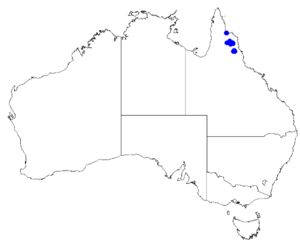Boronia quinkanensis facts for kids
Quick facts for kids Boronia quinkanensis |
|
|---|---|
| Scientific classification | |
| Genus: |
Boronia
|
| Species: |
quinkanensis
|
 |
|
| Occurrence data from Australasian Virtual Herbarium | |
Boronia quinkanensis is a special type of plant that belongs to the citrus family. It's a shrub that grows only in a small part of Queensland, Australia. This plant is known for its pretty pink to white flowers, which have four petals. Many parts of the plant are covered in tiny, star-shaped hairs, and its leaves are made up of several smaller parts called leaflets.
What it Looks Like
Boronia quinkanensis is an upright shrub that can grow up to about 2.5 meters (that's about 8 feet) tall. Its branches, leaves, and flowers are covered in tiny hairs that look like little stars!
Its leaves are "pinnate," which means they look a bit like a feather, with smaller leaf parts called leaflets arranged along a central stem. Each leaf is usually between 6 and 25 millimeters long (less than an inch!) and 4 to 15 millimeters wide. A single leaf can have up to eleven leaflets. The leaflet at the very end is about 6 to 15 millimeters long, and the side leaflets are a bit smaller. The stem that connects the leaf to the branch, called a petiole, is usually 1 to 5 millimeters long.
The flowers grow in small groups of up to three, or sometimes even nine, on a stem called a peduncle, which can be up to 23 millimeters long. Each individual flower sits on a tiny stalk called a pedicel, about 1 to 10 millimeters long.
Each flower has four narrow, triangular sepals, which are like small leaves that protect the flower bud. These sepals are about 3 to 5 millimeters long. The four petals are pink to white and measure about 4 to 5.5 millimeters long. They get bigger as the fruit starts to grow. Inside the flower, there are eight stamens, which are the parts that produce pollen. These stamens are different lengths and shapes. You can see this plant flowering from April all the way through December.
How it Got its Name
Boronia quinkanensis was officially described in 1999 by a scientist named Marco F. Duretto. He published his description in a science journal called Austrobaileya.
The second part of its name, quinkanensis, comes from a place called Quinkan Country in Queensland, Australia. This is where the plant is often found. The ending -ensis is a Latin suffix that means "of" or "from." So, quinkanensis means "from Quinkan Country."
Where it Grows
This boronia plant grows in woodlands and heath areas. These are places with lots of trees or low-growing shrubs, often on sandstone rock formations. You can find it south of a town called Laura in Queensland. It also grows in a separate area, on Mount Mulligan, which is further south. When a plant grows in two separate places like this, it's called a disjunct distribution.
Is it Protected?
The good news is that Boronia quinkanensis is currently listed as "least concern" by the Queensland Government. This means that, for now, there are plenty of these plants, and they are not considered to be in danger of disappearing.

